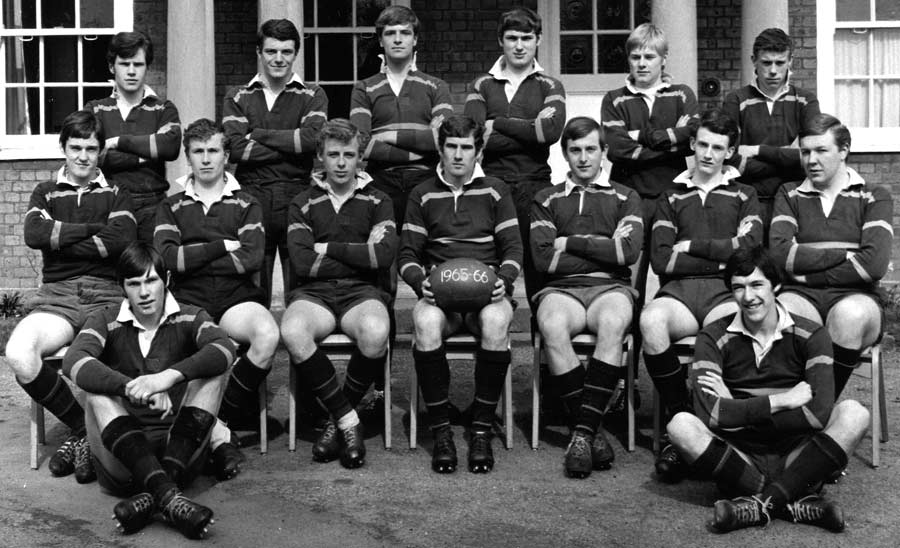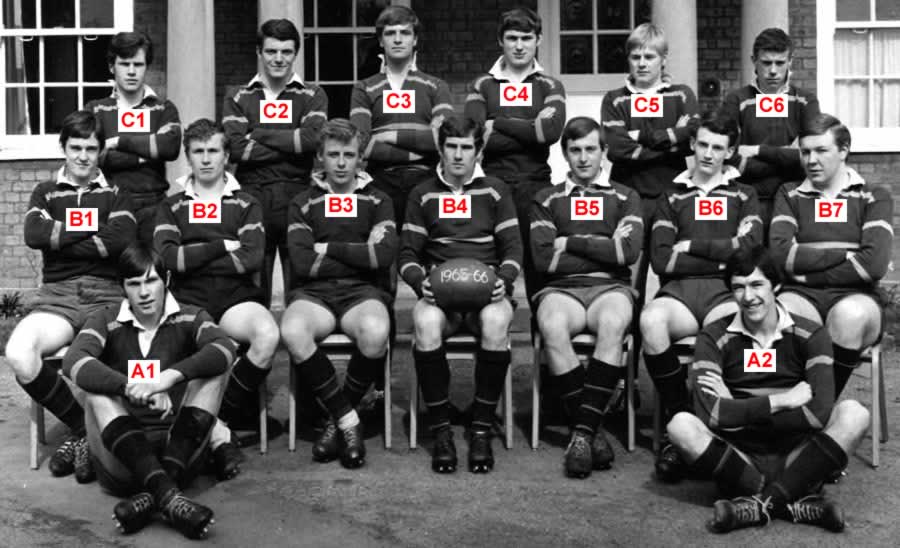
Royal Grammar School, High Wycombe - Rugby 1st XV, 1965/66



Back Row: PL (Peter) Redican (6S3), JF (Jonathan) Killingley (6M2H), DM (Derek) Jones (6M2H), SCB (Stephen Christopher Ben) Tinton (6M2J), C (Chris) Fewtrell (6S3), G (Graham) Davies (6M1).
Middle Row: JW (John) Hume (6M2J), DJ (Dave) Gatland (6B2), PDL (Phil) Brown (6M2J), PD (Duncan) Smith (6M3), A (Arpad, "Burt") Turmezei (6S2), PA (Paul) Beasley (6M2J), APD (Andrew, Doug) Hogg (6M1).
Front Row: PA (Paul) Fountain (6S3), DW (David) Lewis (6M2H).
If you click here, you should be able to see reference numbers appear against each person in the photo (click here to switch it off again).
Jonathan Killingley very kindly sent me this picture - I have taken the names from the May 1966 Wycombiensian. Missing from the photo but who played regularly for the 1st XV: Peter Lavender, George Cutler, Archie Hartwright and John Rivers.
Team Report from the May 1966 Wycombiensian.
RUGBY 1st XV
Six old colours returned this season. P. D. Smith (captain), P. R. Lavender, P. D. L. Brown, A. L. Turmezei, P. A. Beasley and J. W. Hume. Therefore, with J. M. Rivers, G. F. Cutler and A. P. D. Hogg, who also had 1st XV experience, we had the nucleus of a fine side.
Our first match against Windsor G.S. showed our promise and marked the debut of Graham Davies, who appeared to be always confident and reliable; yet after breaking his collar-bone after Christmas, never seemed to return to his old form. Our strength this year lay in our threequarters, and our ability to exploit opportunities. Brown and Beasley combined well together in their second season as half backs. Beasley was potentially dangerous in attack and Brown, always robust and courageous, was again a very dependable scrum-half, although he should have been blessed with a quicker heel on occasions.
The team’s ability to score tries is apparent when one realises that we scored 63 this season, almost twenty more than last. Of these, almost half were scored by the centres, Smith and Gatland. Gatland, in his first year in the side, proved to be a valuable player and his speed and agility were used to great effect. Hume, on the wing, was a great asset to the side, and developed into a very fine player, using his speed and power to score many worthy tries. P. L. Redican, on the left wing, although lacking in speed, was enthusiastic and his play improved through the season, especially in the wet weather, where his reliable touch-kicking saved some tricky situations. Hard first-time tackling and a sound defensive wall was, indeed, a feature of our play.
Our culmination in threequarter play came against City of Oxford, where we scored eleven tries, and won 45-3. This attacking flair lasted, and we beat Borlase 20-0, and we lost only one of the next dozen matches. Our greatest achievement was the victory over Northampton G.S., our biggest rivals, and against whom we never seem quite able to pull off a win. Our forwards played magnificently; they faced a heavy and skilful Northampton pack, which they contained both in the loose and the tight. Among our other wins, we deprived Luton G.S. of their unbeaten record, and in defiance of the abysmal conditions, we scored a try by throwing the ball out to the wing with nonchalant aplomb.
The lack of the quick ball from the tight scrums proved an increasing disadvantage, and Lavender never really settled down in the No. 8 position. This caused a lack of co-ordination at the base of the scrum. Quicker release of the ball might have made all the difference against Tiffin and St. Benedict’s, where our superiority in the backs was marked.
After Christmas the pack seemed to lose much of its previous impetus. Cutler’s absence upset the previous harmony of the pack; he had played well, and had received his colours after being outstanding in the first few games. D. M. Jones, his substitute, for all his inexperience proved enormously useful in the line-outs where his height was an appreciable advantage. In the front row, Rivers was the only veteran player, and his quick reflexes, and generally determined and solid performance at the front of the line-out was a feature of his play. Killingley and Hartwright, although fairly small, compensated for size by their all-round rugby ability. Killingley should be an excellent forward next season. [I think this part of the report was probably penned by Mr. C.M. Haworth - JS]
Turmezei, at open side, was one of the old timers in the team, but didn’t let old-age soften his spirit, and was a fearsome hazard to opposing fly-halves, and his willingness to follow up the loose ball and turn defence into attack was once more used to full advantage. Lavender, though a converted prop, was indispensable, and near the line was a most potent weapon and difficult to detain. Hogg developed into a very able second row player, and proved intelligent and effective in the scrums and line-outs. The blind-side position was a recurrent problem throughout the season. Fewtrell and Fountain started off as the wing forwards, but Fountain was displaced when Turmezei returned, and when Fewtrell, a very persistent and energetic member broke his hand, he was replaced by Tinton, who gradually matured and deservedly won his place towards the close of the season. In general then, the pack although unusually small united well and with a slightly more mobile back-row, could have formed a still more formidable alliance.
This has been a first class season for the 1st XV, and it is a great pity that the attractive rugby produced in the first term, should have declined in the second. Two of the most enjoyable matches were against Old Boys and the Staff. The Old Boys had a strong and interesting side, including the old combination of Fewtrell, Kefford and Douglas, but we artfully contained Fewtrell’s exploitations and won 9-0. It is hard to explain our crumbling at the end of the season, as most of the defeats should never have occurred. There was a long pause after Christmas, when five games were cancelled, and some of our triumphal determination disappeared.. Mr. Rex Jones left at Christmas, and perhaps the Welsh vitalisation that went with him may explain our decay. In any case, we wish him all the best in his new post, and I am sure that he will long be remembered by all those that have known and played under him. For this last season, we, at any rate, owe much to his guidance.
RECORD:
| v. Windsor G.S. | Won |
11- 0 |
Away |
v. St. Bartholomew’s |
Won |
24- 0 |
Home |
v. St. Marylebone G.S. |
Won |
11- 0 |
Away |
v. Watford G.S. |
Draw |
6- 6 |
Home |
v. St. Benedict’s |
Lost |
11-14 |
Home |
v. City of Oxford |
Won |
45- 3 |
Home |
v. Sir William Borlase School |
Won |
20- 0 |
Home |
v. Tiffin |
Lost |
0- 8 |
Home |
v. Abingdon |
Won |
22- 5 |
Home |
v. Emanuel |
Won |
13- 8 |
Home |
v. Luton G.S. |
Won |
6- 5 |
Home |
v. Leighton Park |
Won |
6- 0 |
Away |
v. Hitchin G.S. |
Won |
11- 3 |
Away |
v. Staff |
Won |
16- 0 |
Home |
v. Northampton G.S. |
Won |
8- 0 |
Home |
v. S.R. Thomas’s XV |
Won |
9- 0 |
Home |
v. R.A.F. Halton |
Won |
11- 3 |
Home |
v. St. Nicholas G.S. |
Lost |
6-11 |
Home |
v. Metropolitan Police Cadets |
Lost |
6-11 |
Home |
v. St. Albans G.S. |
Lost |
0-5 |
Away |
v. Jesus College |
Won |
9- 3 |
Home |
Played 21 : Won 15: Drawn 2: Lost 5 : Points For, 246: Points Against, 91.
P. D. SMITH.